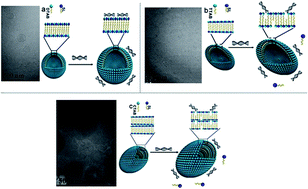Loading capacity and interaction of DNA binding on catanionic vesicles with different cationic surfactants
Abstract
Cationic and anionic (catanionic) vesicles were constructed from the mixtures of sodium laurate (SL) and alkyltrimethylammonium bromide (CnTAB, n = 12, 14, and 16) and were used to control the loading capacity of DNA. The binding saturation point (BSP) of DNA to catanionic vesicles increases with the chain length of cationic surfactants, which is at 1.0, 1.3 and 1.5 for CnTAB with n = 12, 14, and 16, respectively. Our measurements showed that the loading capacity and affinity of DNA can be controlled by catanionic vesicles. It increases with the chain length of cationic surfactants. Because of a large reduction in surface charge density, catanionic vesicles are prone to undergo re-aggregation or fusion with the addition of DNA. DNA molecules can still maintain original coil state during the interaction with catanionic CnTAL vesicles. 1H NMR data reveals that the obvious dissociation of anionic ions, L−, from catanionic C14TAL vesicles is due to the interaction with DNA; however, this phenomenon cannot be observed in C12TAB–SL vesicles. Agarose gel electrophoresis (AGE) results demonstrate that the electrostatic interaction between the two oppositely charged cationic and anionic surfactants is stronger than that between DNA and cationic surfactant, CnTAB (n = 12, 14, and 16). Not only is the dissociation of L− simply determined by the charge competition, but it also depends largely on the variations in the surface charge density as well as the cationic and anionic surfactant competing ability in geometry configuration of catanionic vesicles. The complicated interaction between DNA and catanionic vesicles induces the deformation of cationic vesicles. Our results should provide clear guidance for choosing more proper vectors for DNA delivery and gene therapy in cell experiments.


 Please wait while we load your content...
Please wait while we load your content...